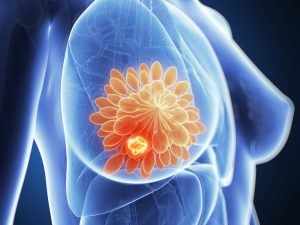Breast Cancer and physical activity
Breast Cancer: definition and symptoms
Breast cancer is the 8th leading cause of death in the Grand-Duchy of Luxembourg, accounting for 2.5% of all deaths. In females, it is the leading cause (20.1%) of death from cancer [1]. This cancer, which occurs mainly in women, is a malignant tumor that starts in the cells of the breast and can grow into surrounding tissues or spread (metastasize) to distant areas of the body. The symptoms may include a lump in the breast, a breast modification (shape or size) or discharge from a nipple. The main modifiable risk factors are overweight/obesity, dense breasts, alcohol consumption, hormone replacement therapy, taking birth control pills, and physical inactivity [2].
The effects of physical activity on Breast Cancer
Physical activity is associated with a decreased risk of breast cancer recurrence and mortality. The more time the patients spend exercising at moderate intensity, the lower the risk of recurrence and mortality [3]. During treatment, moderate physical activity prevents the decrease in aerobic fitness, quality of life, psychological health and physical functioning, and the increase in levels of fatigue and body weight. It may also compensate for the side effects of the treatment (e.g. chemotherapy) on the cardiovascular system (e.g. heart failure), the lymphatic system (i.e. lymphedema), bone density (i.e. bone mineral loss), and joint health (i.e. shoulder pain, loss of range of motion). After treatment, it improves muscular strength and endurance, fatigue levels, psychological health and quality of life [4].
What are the risks?
The risks of physical activity after a diagnosis of breast cancer are limited. During and after treatment, physical activity should be supervised to avoid side effects such as an increase in wound drainage volume and duration (especially in the early phase). In addition, the decrease in cardiorespiratory fitness which often occurs after each cycle of chemotherapy is a barrier to physical activity which should therefore be adapted by decreasing or splitting its duration. Types of exercise and environmental conditions may be adapted if patients are wearing a wig and / or an uncomfortable bra (rubbing between the burn skin and the bra).
Recommendations
Physical activity is strongly recommended after a diagnosis of breast cancer. After diagnosis, physical activity guidelines recommend 150 minutes of moderate physical activity per week, with a target duration of 50-60 minutes per session [3]. Aerobic physical activity and progressive resistance training are recommended, especially to limit lymphedema [5]. Aerobic exercise that should be adapted to the capacity of each survivor, may include outdoor or treadmill walking, stationary cycling, recumbent stepping, or walking on an underwater treadmill. Resistance training and flexibility emphasize all of the major muscle groups [6], but especially the upper limbs (resistance up to 75-85% of the maximal weight that can be lifted). In addition, stretching and proprioceptive exercises are also recommended to regain strength and full range of motion of the shoulders [7].
Related groups
- Fondation Cancer
- Association Luxembourgeoise des Groupes Sportifs Oncologiques
- Think Pink Luxembourg
References
- World Health Organisation. Disease and injury country estimates – Burden of disease. 2011 [cited 2014 09/09/2014]; Available from: http://www.who.int/healthinfo/global_burden_disease/estimates_country/en/.
- Medlineplus. Breast Cancer. 2014 [cited 2014 18/09/2014]; Available from: http://www.nlm.nih.gov/medlineplus/breastcancer.html.
- Schmid D, Leitzmann MF. Association between physical activity and mortality among breast cancer and colorectal cancer survivors: a systematic review and meta-analysis. Ann Oncol 2014;25(7):1293-311. Available at: http://dx.doi.org/10.1093/annonc/mdu012.
- Brenner DR, Neilson HK, Courneya KS, Friedenreich CM. Physical Activity After Breast Cancer: Effect on Survival and Patient-Reported Outcomes. Current Breast Cancer Reports 2014.1-12.
- Rock CL, Doyle C, Demark-Wahnefried W, et al. Nutrition and physical activity guidelines for cancer survivors. CA Cancer J Clin 2012;62(4):243-74. Available at: http://dx.doi.org/10.3322/caac.21142.
- Hsieh CC, Sprod LK, Hydock DS, Carter SD, Hayward R, Schneider CM. Effects of a supervised exercise intervention on recovery from treatment regimens in breast cancer survivors. Oncol Nurs Forum 2008;35(6):909-15. Available at: http://dx.doi.org/10.1188/08.ONF.909-915.
- Galantino ML, Stout NL. Exercise interventions for upper limb dysfunction due to breast cancer treatment. Phys Ther 2013;93(10):1291-7. Available at: http://dx.doi.org/10.2522/ptj.20120049.
Year of publication
2015
